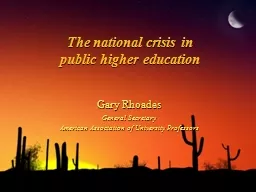

public higher education Gary Rhoades General Secretary American Association of University Professors The higher education we choose The California we choose A crisis 30 years in the making The current crisis comes after 30 years of academic capitalism which has heightened social and ID: 550321
Download Presentation The PPT/PDF document "The national crisis in" is the property of its rightful owner. Permission is granted to download and print the materials on this web site for personal, non-commercial use only, and to display it on your personal computer provided you do not modify the materials and that you retain all copyright notices contained in the materials. By downloading content from our website, you accept the terms of this agreement.
Slide1
The national crisis inpublic higher education
Gary Rhoades
General Secretary
American Association of University ProfessorsSlide2
The higher education we chooseThe California we chooseSlide3
A crisis 30 years in the makingThe current crisis comes after 30 years of “academic capitalism,” which has heightened social and educational aspects of the crisis.
The crisis has four key dimensions: structure of employment; shifting of cost burden; stratification of access; educational outcomes.
We face a choice: Do we accelerate down the current path?; or do we reorient to expand opportunity and success, and more fully realize our country/state’s potential?Slide4
A crisis along four dimensionsStructure of employment: from 2/3 tt to 2/3 contingent with reduced ability to engage students and limited academic freedom to challenge them; decline of college teaching as a middle-class career; impending retirement of baby boom professoriate.
The CSU exemplifies these patterns: slightly fewer t & tt FTE faculty in 2008 than 1988, versus 50% more lecturers; 500 fewer t & tt faculty in 2010 than 2007.Slide5
…dimension #2Shifting of cost burden: from state support and grants to tuition and student loans. A crushing debt burden (as big as credit card debt)—we are mortgaging our future.
We are reneging on our commitment as a country, and as states, to invest in our students and in our future (LEAP, Michigan’s promise). Here California as a state does better than most, but California universities have been dramatically increasing tuition.Slide6
…dimensions # 3 & 4Stratification of access: Cascading effects on access by social class. Household income of UCLA v USC students; CSU-cc’s. We are essentially rationing hed by race/class.
Educational outcomes: impact of the above patterns on graduation rates and student learning outcomes. Students pay more for less access to faculty and professionals, and the have less time for studying b/c they are working more to pay for their education.Slide7
Economic stratification in US postsecondary education
??
WHERE
THE MONEY GOES, WHERE THE STUDENTS ARE ENROLLED
Source: Delta Cost Project
IPEDS
Database,
1987-2008
; 10-year matched set.Slide8
Follow the trend, or reorientCurrent struggles make clear what is at stake.A tale of two Ohio’s: Eric Fingerhut v Jim Petro. Foregrounding public responsibility of state; foregrounding univ’s entrepreneurial flexibility in facilities and tuition. Facilities vs faculties; managing vs uncapping tuition. Follows the 30 year trend.
Portland State Univ vs UO: Local focus through local funding. Breaking the trend, it could prioritize the local, public orientation.Slide9
Lessons for California facultySpeak now or forever hold your peace. Choices are being made about the future of the profession, the academy, and the nation. I encourage you to demonstrate your support for public higher education. April 13
th
.
We cannot simply do more of the same, but to innovate and do more for more students, public hed needs more public investment.
The issue is not simply how to balance the budget; it also is how to lay the foundation for a prosperous future.Slide10
Thank you…